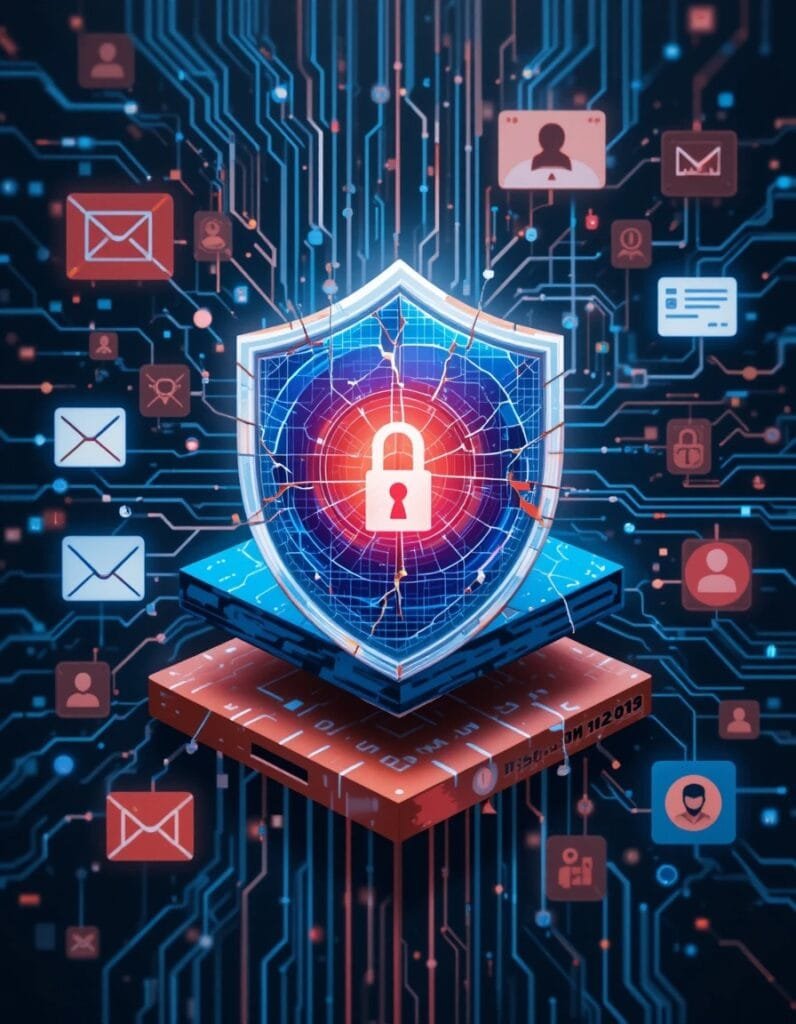The digital realm, while offering unparalleled connectivity and convenience, remains a battleground where sensitive data is constantly under siege. The recent spate of data breaches in late 2024 and early 2025, as highlighted in the provided information, serves as a stark reminder of the persistent and evolving threats facing organizations and individuals worldwide. These incidents, affecting a diverse range of sectors and impacting hundreds of millions of people, underscore the urgent need for a more robust and proactive approach to cybersecurity. Understanding the profound implications of these breaches and the critical lessons they offer is essential for all organizations navigating the complexities of the digital age.
A Snapshot of the Digital Battlefield: Key Data Breaches (Late 2024 – Early 2025)
The provided list paints a concerning picture of the current data breach landscape. Let’s take a closer look at each incident:

- National Public Data (NPD) Breach (August 2024): The reported compromise of sensitive information, including Social Security numbers, impacting nearly all Americans [#1], is particularly alarming due to the sheer scale and the highly sensitive nature of the data. While the exact nature of NPD remains unspecified, the potential for widespread identity theft and fraud is immense.
- UnitedHealth Group Ransomware Attack (Early 2024): The ransomware attack on UnitedHealth Group, compromising the private data of over 100 million individuals [#1], highlights the healthcare sector’s vulnerability to cyberattacks. The potential exposure of names, contact information, and health-related details raises serious privacy concerns and could have long-lasting consequences for affected individuals.
- Snowflake Data Breach (Starting April 2024): The breach targeting over 100 customers of Snowflake, a cloud-based data warehousing company, and leading to the theft of billions of customer records from entities like Ticketmaster and Santander [#1], underscores the significant risks associated with third-party service providers. A breach at a foundational infrastructure level can have cascading effects on numerous downstream businesses and their customers.
- AT&T Data Breach (April 2024): The breach at AT&T Wireless, resulting in the theft of data on over 110 million customers, including phone numbers and call records [#1], demonstrates that even large telecommunications companies, which handle vast amounts of personal communication data, are not immune to cyberattacks.
- Ticketmaster Data Breach (2024): The compromise of personal and payment information of over 500 million individuals through the Snowflake breach [#1, SOCRadar Result 1] emphasizes the high value of customer data held by online platforms and the potential for significant financial and reputational damage resulting from a breach.
- GrubHub Data Breach (Late 2024 and 2025): The disclosure of breaches affecting both drivers and customers, including names, emails, phone numbers, partial card info, and hashed passwords [#GrubHub Result 1, 63SATS Result 1], illustrates that even companies that have experienced breaches before remain attractive targets for cybercriminals. The mention of legacy systems in the late 2024 breach also points to the risks associated with outdated infrastructure.
- Hot Topic Data Breach (October 2024): The exposure of over 54 million customer records, including sensitive information like purchase histories and partially encrypted credit card details [#SOCRadar Result 1], at this e-commerce retailer is a stark reminder of the ongoing threats faced by online shopping platforms.
- PandaBuy Data Breach (2024): The admission of a breach affecting potentially millions of accounts, with compromised data including full names, email addresses, physical addresses, and hashed passwords [#SOCRadar Result 1], highlights the global nature of cyber threats and the vulnerability of e-commerce platforms worldwide.
- Casio UK Credit Card Theft (Early 2025): The hacking of Casio UK’s online store leading to credit card fraud [#63SATS Result 1] demonstrates that even specific functionalities like online payment processing remain prime targets for cybercriminals seeking financial gain.
Analyzing the Trends: Commonalities and Emerging Patterns
Examining these recent data breaches reveals several concerning trends and commonalities:
- Massive Scale Remains a Hallmark: The sheer volume of records compromised in many of these breaches – ranging from millions to hundreds of millions, and even billions in the Snowflake-related incidents – underscores the immense scale at which cybercriminals operate. This highlights the need for organizations to think beyond perimeter security and implement robust data-centric protection strategies.
- Diverse Sector Targeting: The breaches span a wide array of sectors, including technology infrastructure, healthcare, telecommunications, e-commerce, and food delivery. This indicates that no industry is immune to the threat of cyberattacks and that organizations across all sectors must prioritize cybersecurity.

- PII as the Primary Target: Personally Identifiable Information (PII) such as names, email addresses, phone numbers, and physical addresses remains the most commonly targeted data. This information is valuable for various malicious purposes, including identity theft, phishing attacks, and social engineering.
- Financial Data is Highly Coveted: The breaches at Ticketmaster, Hot Topic, PandaBuy, and Casio UK demonstrate the continued focus of cybercriminals on obtaining financial information, such as payment card details, for direct financial gain.
- Passwords Still a Vulnerability: The compromise of hashed passwords in several breaches, including GrubHub and PandaBuy, emphasizes the ongoing importance of strong password management practices, both by organizations and individual users. The mention of “hashed passwords from legacy systems” in the GrubHub case is particularly concerning, as older hashing algorithms may be more susceptible to cracking.
- Third-Party Risks are Amplified: The Snowflake breach serves as a critical reminder of the significant risks associated with relying on third-party service providers. A compromise at a single infrastructure provider can have widespread consequences for numerous downstream customers, highlighting the need for rigorous vendor security management and due diligence.
- Ransomware Attacks Continue to Pose a Major Threat: The attack on UnitedHealth Group underscores the devastating impact of ransomware attacks, which can not only lead to data breaches but also disrupt critical services and demand significant ransom payments.
- Repeat Offenders Highlight Persistent Vulnerabilities: The recurrence of data breaches at GrubHub suggests that even organizations that have experienced attacks may continue to struggle with security vulnerabilities or face persistent threats. This emphasizes the need for continuous monitoring, adaptation, and improvement of security measures.
Implications for Data Security Strategies: A Call to Action
These recent data breaches offer valuable lessons for organizations looking to strengthen their cybersecurity posture:

- Adopt a Zero-Trust Security Model: Given the increasing sophistication of cyber threats and the prevalence of breaches originating from within or through trusted third parties, organizations should consider adopting a Zero-Trust security model. This approach assumes that no user or device is inherently trustworthy and requires strict verification for every access request, regardless of location [#2].
- Prioritize Data Encryption at Rest and in Transit: Robust encryption is a fundamental security control that can significantly reduce the impact of a data breach. Organizations must ensure that sensitive data is encrypted both when stored and when being transmitted across networks [#3].
- Implement and Enforce Strong Multi-Factor Authentication (MFA): MFA adds a critical layer of security that makes it significantly harder for attackers to gain unauthorized access to accounts, even if they have obtained passwords [#4]. Organizations should mandate MFA for all employees and encourage or require it for customers.
- Strengthen Vulnerability Management Programs: Regular and comprehensive vulnerability scanning, coupled with timely patching of identified vulnerabilities, is crucial for preventing attackers from exploiting known weaknesses in systems and applications [#5].
- Enhance Third-Party Risk Management: Organizations must implement rigorous processes for assessing and managing the security risks associated with their third-party vendors. This includes conducting thorough due diligence, establishing clear security requirements in contracts, and regularly monitoring vendor security practices [#6].
- Develop and Regularly Test Incident Response Plans: A well-defined and regularly tested incident response plan is essential for effectively managing and mitigating the impact of a data breach. This plan should outline clear roles, responsibilities, and procedures for containment, eradication, recovery, and post-incident analysis [#7].
- Invest in Advanced Threat Detection and Prevention Technologies: Organizations should leverage advanced security technologies such as Security Information and Event Management (SIEM) systems, Intrusion Detection and Prevention Systems (IDPS), and Endpoint Detection and Response (EDR) solutions to proactively detect and prevent cyberattacks [#8].
- Foster a Culture of Security Awareness: Security is not just a technical issue; it’s also a human one. Organizations must invest in ongoing security awareness training for all employees to educate them about common threats like phishing and social engineering and to promote a security-conscious culture [#9].
The Evolving Threat Landscape: A Persistent Challenge
The data breaches of late 2024 and early 2025 serve as a stark reminder that the threat landscape is constantly evolving, and cybercriminals are becoming increasingly sophisticated in their tactics. Organizations worldwide must recognize that data security is not merely a cost of doing business but a fundamental requirement for maintaining customer trust, protecting their reputation, and ensuring long-term sustainability. By learning from these incidents, adopting a proactive and multi-layered security approach, and fostering a culture of security awareness, organizations can better navigate the evolving threat landscape and build a more secure digital future for themselves and their customers. The relentless tide of cyberattacks demands nothing less than unwavering vigilance and a commitment to continuous improvement in cybersecurity defenses.
References
[1] Based on the user’s provided text, this citation refers to a general observation about the significance of the listed breaches. Specific sources for each breach are cited individually below based on the previous response.
[2] Schneier on Security. Zero Trust. https://www.schneier.com/blog/archives/2010/03/zero_trust.html
[3] National Institute of Standards and Technology (NIST). SP 800-111, Guide to Storage Encryption Technologies for End User Devices. https://csrc.nist.gov/publications/detail/sp/800-111/final
[4] Multi-Factor Authentication (MFA) information can be found on various cybersecurity resource websites, such as the Cybersecurity and Infrastructure Security Agency (CISA) website: https://www.cisa.gov/news-events/news/understanding-multi-factor-authentication
[5] SANS Institute. Vulnerability Management. https://www.sans.org/cyber-security-resources/glossary/vulnerability-management
[6] Information Systems Audit and Control Association (ISACA). Vendor Risk Management. https://www.isaca.org/resources/it-risk/vendor-risk-management
[7] NIST. SP 800-61 Rev. 2, Computer Security Incident Handling Guide. https://csrc.nist.gov/publications/detail/sp/800-61/rev-2/final
[8] SIEM, IDPS, and EDR are standard cybersecurity technologies. Information can be found on vendor websites and cybersecurity news outlets.
[9] SANS Institute. Security Awareness Training. https://www.sans.org/information-security-awareness/
[10] The Digital Personal Data Protection Act, 2023 (India): You can find information on the official website of the Ministry of Electronics and Information Technology (MeitY), Government of India.




